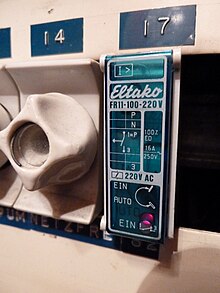Power switch

A mains isolating switch (also field isolating switch , automatic mains disconnection device , mains decoupler and similar names) is an electrical switching element that can switch off the mains voltage after switching off all connected consumers in a circuit and switch it on again after switching on a consumer. The use of appropriate technology is usually motivated by the view that electrosmog is harmful. Furthermore, it functions as a switch for additional circuits (e.g. lights, sockets) within IT-sensitive rooms when these are not used and the electrical fields are then minimized, although mostly shielded cables are used.
term
In the electrotechnical sense, the term mains isolation switch is incorrect for these switching elements. In electrical engineering, the term disconnection describes the all-pole disconnection of electrical systems or loads from live parts. Power switches cannot be used for this safety-relevant task.
use
When the alternating voltage is switched off, alternating electrical fields that are also present when no current is flowing are eliminated. After switching off, the line is monitored with a weak DC voltage (1.5 V - 12 V depending on the manufacturer); as soon as a consumer is switched on, the mains voltage is switched on again. This only works with devices that can be switched off completely. Because of the switch-on / switch-off threshold, "standby" consumers (televisions, mains-operated clocks, ...) should not be operated on circuits with built-in mains isolation switch elements, since then either the switch-off function does not respond and the hoped-for effect is not achieved, or the connected device is switched off because its power consumption is below the switch-off threshold.
The use of commercially available phase testers poses a risk when mains isolators are present, as these only display the test voltages from approx. 100 V and since these draw very little current, the mains is not switched on. If the mains is switched off because no other consumer is drawing current, the phase tester indicates that there is no voltage. If the supposedly voltage-free components come into contact, and thus earth , the mains isolator switches on the mains and causes a shock to the body and possibly an electrical accident . The presence of a mains isolation switch can only be seen in the electrical distribution .
Working principle
Electrical installations emit an electric field due to the applied voltage and a magnetic field due to the flowing current. The two fields can be viewed separately in the near field , i.e. at distances far below the wavelength (6000 km at a network frequency of 50 Hz ). When the consumer is switched off, the magnetic field disappears by itself. A mains isolator then also prevents the electric field. It should be borne in mind that with installations under plaster only an extremely small part of the electrical field can escape from the wall anyway.
Individual evidence
- ↑ Safety when working on electrical systems. (PDF; 2 MB) BG ETEM, October 2015, accessed on October 12, 2016 .
- ↑ Mains isolation - how a mains isolation switch works. building ecologically, accessed on October 12, 2016 .
